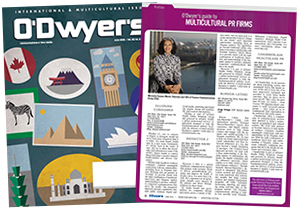|
|
|
|
As the marketing world continues to address and gain value from the new digital landscape, two current dynamics stand out to us. One is the promise of purely automated social-based marketing, which clearly lacks substance without content — hence the rise of content marketing — therefore causing many forms of marketing to look more and more like PR every day. The second is the avalanche of content — much of it lightweight or bordering on spam — which will likely result in a “content bubble” to which potential customers who become wise will, ultimately, ignore.
While PR has gone from cool to old-school and back to cool again — remember the cry of “PR is Dead!” — we all know how everything works in cycles. We believe those of us in the PR industry have forged the skills around messaging or storytelling to add a higher level of value to today’s marketing mix. We must constantly look to elevate the practice of PR into a strategic, high-value asset and not slip into becoming just a tactical commodity. While any and all forms of content may be king, what we say and the messages we convey are more vital than ever.
It should be our collective goal as an industry to own and guide not just stories, but the strategic narrative. This higher-level messaging helps organizations define our constantly changing world. The practice of telling an industry strategic narrative, which is based on the unique perspective and vision an organization has for its industry, is often lacking in today’s marketing communications. And, when you look at the disruption and mash-up of industries and capabilities all around, there’s a great opportunity to create messaging that defines new market spaces, topics or processes.
With a focus on industry leadership, a well thought-out strategic narrative provides the much-needed fuel to drive all forms of marketing that require quality, meaningful topics and themes to be effective. A strategic narrative is less about the company and what it does, but demands an organization define its view of the world (industry), what positive change needs to occur and what role it will play to promote and advance that positive change. This is a powerful proposition today, considering how difficult it is to not only stand for something, but to stand apart and above the competition.
Our road to up-leveling messaging to an industry narrative happened when a local Colorado manufacturer of industrial hardware products came to Catapult with a specific request: can you help us build a new market category?
The company had acquired a software platform that automated the gathering and processing of data that had been done manually for decades. The technology was new and disruptive for the market, within an industry that was very “old school” and set in its ways. The main issue, according to the customer: the sales team was struggling to sell its software because an “existing category” did not exist.
The sales team needed to show customers there was a credible market category that supported adopting the technology. And, equally important, made it easier for prospects to sell the concept internally to management and the folks in purchasing. Without a nice “bucket” to categorize the product, sales efforts were bogged down in explaining technical features, how the product worked and other lower-level issues that derailed the sales process.
We agreed to take the project and, while prepping for the kickoff strategy session, realized we needed to spend almost all of our time digging into industry dynamics — not talking about the company and product. What were the prevailing trends? What were the perceptions and misperceptions that existed when it came to automation and technology? What were the opportunities — as an industry — to adopt automation software as a means to improve the overall success of the bigger, overall industry category?
The result was the development and launch of a new category that was based on Lean manufacturing principles. The ensuing messaging development and launch revealed several things to us:
We were telling more of a strategic narrative, defining the industry, helping advance it, changing long-held perceptions and shifting away from talking about the company and product. We were communicating more like industry analysts and true industry thought leaders.
The less the company talked about themselves the better, and the quicker the company was recognized as a software innovator and not just a products company. It was the industry vision that made the company stand out and made the market take notice.
Media and analysts loved it. They were eager to learn, hear the company’s vision and feel part of an emerging trend to help their industry.
It provided endless topics for thought leadership, including white papers, by-lined articles, speaking and other educational outlets. It also provided meaningful fodder for social media and content marketing.
It attracted support. One of the largest manufacturers in the world loved the idea, and partnered with the client to co-present the new category concept at a major industry conference.
It was fun. Defining and launching a new category was exciting and different. Seeing how it was being accepted within an industry was fascinating and rewarding.
As marketers, it moved us from convincing to leading.
And, finally, it dawned on us that all of our successful clients had one thing in common: they all were category leaders!
I hope you can see the opportunity that lies in defining a market category — or creating a new one — as a means of talking less about “me,” and more about the world.
Over the years we created a formalized process for developing a strategic narrative, and using PR and associated marketing practices to develop an entirely new market space. We call it Strategic Narrative Marketing, and are now publishing a guidebook, as our own contribution to the marketing industry, to help PR professionals think about and develop messaging that adds value and matters in the market.
* * *
Guy Murrel is Co-Founder and Principal of Catapult PR in Boulder, CO.




 Abandon traditional content plans focused on a linear buyer progression and instead embrace a consumer journey where no matter which direction they travel, they get what they need, stressed marketing pro Ashley Faus during O'Dwyer's webinar Apr. 2.
Abandon traditional content plans focused on a linear buyer progression and instead embrace a consumer journey where no matter which direction they travel, they get what they need, stressed marketing pro Ashley Faus during O'Dwyer's webinar Apr. 2. Freelance marketers and the companies that hire them are both satisfied with the current work arrangements they have and anticipate the volume of freelance opportunities to increase in the future, according to new data on the growing freelance marketing economy.
Freelance marketers and the companies that hire them are both satisfied with the current work arrangements they have and anticipate the volume of freelance opportunities to increase in the future, according to new data on the growing freelance marketing economy. Home Depot's new attempt to occupy two market positions at once will require careful positioning strategy and execution to make it work.
Home Depot's new attempt to occupy two market positions at once will require careful positioning strategy and execution to make it work. Verizon snags Peloton Interactive chief marketing officer Leslie Berland as its new CMO, effective Jan. 9. Berland succeeds Diego Scotti, who left Verizon earlier this year.
Verizon snags Peloton Interactive chief marketing officer Leslie Berland as its new CMO, effective Jan. 9. Berland succeeds Diego Scotti, who left Verizon earlier this year.  Norm de Greve, who has been CMO at CVS Health since 2015, is taking the top marketing job at General Motors, effective July 31.
Norm de Greve, who has been CMO at CVS Health since 2015, is taking the top marketing job at General Motors, effective July 31.


 Have a comment? Send it to
Have a comment? Send it to 
No comments have been submitted for this story yet.